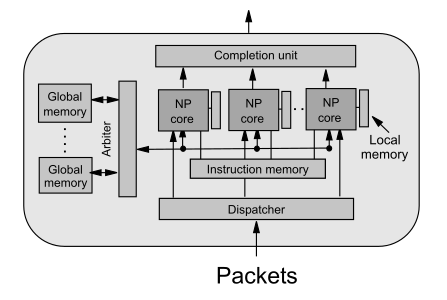
Links
Abstract
In this paper, we present five case studies of advanced networking functions that detail how a network processor (NP) can provide high performance and also the necessary flexibility compared with Application-Specific Integrated Circuits (ASICs). We first review the basic NP system architectures, and describe the IBM PowerNP architecture from a data-plane as well as from a control-plane point of view. We introduce models for the programmer’s views of NPs that facilitate a global understanding of NP software programming. Then, for each case study, we present results from prototypes as well as general considerations that apply to a wider range of system architectures. Specifically, we investigate the suitability of NPs for
- Quality of Service (active queue management and traffic engineering),
- header processing (GPRS tunneling protocol),
- intelligent forwarding (load balancing without flow disruption),
- payload processing (code interpretation and just-in-time compilation in active networks), and protocol stack termination (SCTP).
BibTeX (Download)
@article{Haas2003Creating,
title = {Creating Advanced Functions on Network Processors: Experience and Perspectives},
author = {Robert Haas and Clark Jeffries and Lukas Kencl and Andreas Kind and Bernard Metzler and Roman Pletka and Marcel Waldvogel and Laurent Freléchoux and Patrick Droz},
url = {https://netfuture.ch/wp-content/uploads/2003/haas03creating.pdf},
year = {2003},
date = {2003-01-01},
urldate = {1000-01-01},
journal = {IEEE Network},
volume = {17},
number = {4},
pages = {46-54},
abstract = {In this paper, we present five case studies of advanced networking functions that detail how a network processor (NP) can provide high performance and also the necessary flexibility compared with Application-Specific Integrated Circuits (ASICs). We first review the basic NP system architectures, and describe the IBM PowerNP architecture from a data-plane as well as from a control-plane point of view. We introduce models for the programmer's views of NPs that facilitate a global understanding of NP software programming. Then, for each case study, we present results from prototypes as well as general considerations that apply to a wider range of system architectures. Specifically, we investigate the suitability of NPs for<ul><li>Quality of Service (active queue management and traffic engineering),</li><li>header processing (GPRS tunneling protocol),</li><li>intelligent forwarding (load balancing without flow disruption),</li><li>payload processing (code interpretation and just-in-time compilation in active networks), and protocol stack termination (SCTP).</li></ul>Finally, we summarize the key features as revealed by each case study, and conclude with remarks on the future of NPs.},
keywords = {Active Networks, Network Processors, Quality of Service, Replication},
pubstate = {published},
tppubtype = {article}
}



